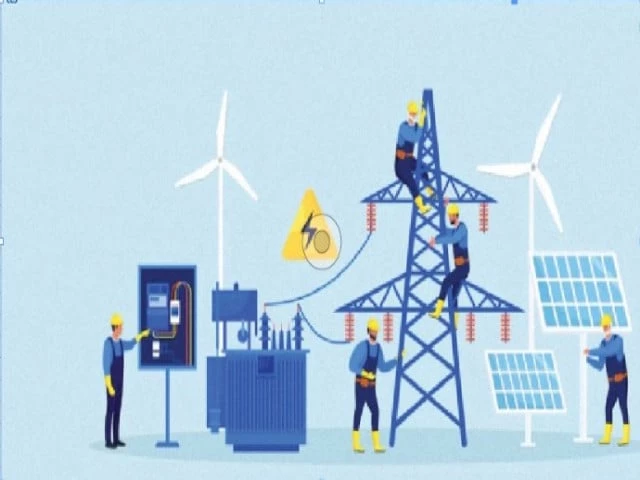Islamabad:
The government managed to limit the outstanding quota of the China-Pakistan Economic Corridor (CPEC) power projects for RS423 billion in June this year, which may also be soon to be run, subject to early resolution of the issue of interest on late payments.
The official documents showed that from the end of the financial year 2024-25, the outstanding energy payments for Chinese power plants were RS423 billion. This was RS22 billion, or 5.5%, more than the previous financial year.
The details showed that since 2017, the country has paid RS5.1 trillion in energy costs to the 18 Chinese power plants equal to 92.3% of the invoiced amount, including interest. The Pakistani authorities believe that the actual remaining energy costs were less than RS300 billion, and the rest of the amount was due to addition to late payment.
The government is in the process of taking almost RS1.3 trillion in fresh loans from the local business banks to withdraw the circular debt that it owes the state -owned power plants, nuclear power plants, privately owned facilities and the Chinese facilities.
According to one of the conditions laid down by the federal cabinet, the authorities will negotiate with the power producers to waive interest payments in return for having made in advance full payments, said a government official who is part of these discussions.
The Chinese Waste may not have interest costs due to their internal claims, which would leave the government with the possibility of either making full payments at once or clearing the fees when fiscal policy is created.
RS423 billion unpaid debt is in violation of the 2015 CPEC Energy Framework Agreement, which binds the government to fully clear the quota regardless of whether the authorities can recover the amounts from final consumers.
Together with security, the non-fulfillment of CPEC contracts is one of the reasons for slow progress in economic and commercial relations between the two nations. Prime Minister Shehbaz Sharif is expected to visit China next month, and one of the agenda’s goods lures Chinese investors to Pakistan by tackling their concerns.
According to the CPEC Energy Framework agreement, Pakistan was obliged to create a rotating fund with 21% of power invoice to protect Chinese companies from circular debt crisis. However, the former government opened a Pakistan Energy Revolving account in the State Bank of Pakistan in October 2022 with RS48 billion in annual awards. But it is limited withdrawal to RS4 billion per year. Month, which led to the current debt portfolio of RS423 billion.
The documents show that Pakistan owed RS87 billion to the imported coal-fired Sahiwal power plant, while the company received RS1.14 trillion in the last eight years of its activities. The country also owed RS69 billion to the coal-fired HUB power project compared to the total claim of RS834 billion.
The outstanding remaining charges for the coal-fired Port Qasim power plant were RS85.5 billion against the total bills of over RS1 trillion. The Port Qasim quota was about RS15 billion higher than the previous fiscal year.
THAR COAL PROJECT fees remained on RS55.5 billion. It had claimed RS566 billion of fees. The outstanding quota for Karo Power Company were RS11 billion, Engro Powergen Thar Coal RS38 Billion, Matiari Lahore Transmission Line RS28.5 billion and Thar Energy Limited RS8.3 Billion.
The Chinese government has repeatedly raised this issue with Pakistan through diplomatic channels, including Pakistan’s Embassy in Beijing and its own embassy in Islamabad.
It is expected that when the procedural formalities are completed by the commercial banks and the federal government’s units, the circular debt amounts would begin to go down.
The government had reached an agreement with commercial banks to borrow RS1.25 trillion on less than an 11% interest rate as part of its three -shaped strategy to eliminate the circular debt and restore the viability of the power sector.
Banks are expected to pay the loans shortly after fulfilling procedural requirements.
The deal is said to be approx. 3% to 5% cheaper than the interest on the existing facilities and the sanctions that the government pays not to make timely payments of the energy purchases. RS1.25 trillion debt is taken on the books of the Central Power Calchasing Agency (CPPA) and it would not be part of the total public debt.
The government paid up to 14% costs for the business banks on the loans it had taken in the past to withdraw the circular debt and up to 16% price to the independent power producers (IPPs) so as not to make timely payments to them.
Out of the total RS2.4 trillion existing circular debt stock, the RS1.5 trillion principal is needed to eliminate the debt portfolio.
Out of RS1.25 trillion, approx. RS660 billion is settled against the limited debt that holds limited debt. This debt had been achieved in the past with a rate on the kibor plus up to 2%. The powers of the nuclear plants will come around the RS280 billion, while the LNG power plants are expected to receive RS220 billion.
Pakistan’s previous efforts to get the energy debt that has been re -planned has not succeeded, according to the government sources. Finance Minister Muhammad Aurangzeb and Energy Minister Sardar Awais Laghari led these efforts.
Pakistani officials had requested an extension of five to eight years to repay energy debt, converted the US dollar-based interest payments to Chinese currency and reduced the total interest rates for both CPEC and non-CPEC Chinese-funded projects.



